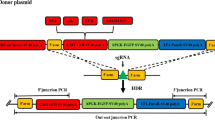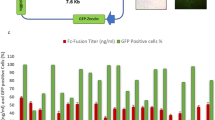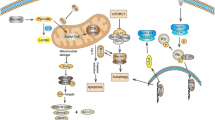Abstract
Lactate, one of the major waste products in mammalian cell culture, can inhibit cell growth and affect cellular metabolism at high concentrations. To reduce lactate formation, lactate dehydrogenase-A (LDH-A), an enzyme catalyzing the conversion of glucose-derived pyruvate to lactate, was down-regulated by an expression vector of small interfering RNAs (siRNA) in recombinant Chinese hamster ovary (rCHO) cells producing human thrombopoietin (hTPO). Three clones expressing low levels of LDH-A, determined by reverse transcription-PCR and an enzyme activity test, were established in addition to a negative control cell line. LDH-A activities in the three clones were decreased by 75–89%, compared with that of the control CHO cell line, demonstrating that the effect of siRNA is more significant than that of other traditional methods such as homologous recombination (30%) and antisense mRNA (29%). The specific glucose consumption rates of the three clones were reduced to 54–87% when compared to the control cell line. Similarly, the specific lactate production rates were reduced to 45–79% of the control cell line level. In addition, reduction of LDH-A did not impair either cell proliferation or hTPO productivity. Taken together, these results show that the lactate formation rate in rCHO cell culture can be efficiently reduced through the down-regulation of LDH via siRNA.




Similar content being viewed by others
References
Baumgart E, Fahimi HD, Stich A, Volki A (1996) L-lactate dehydrogenase A4-and A3B isoforms are bona fide peroxisomal enzymes in rate liver: evidence for involvement in intraperoxisomal NADH reoxidation. J Biol Chem 271:3846–3855
Bertrand JR, Pottier M, Vekris A, Opolon P, Maksimemko A, Malvy C (2002) Comparison of antisense oligonucleotides and siRNAs in cell culture and in vivo. Biochem Biophys Res Commun 296:1000–1004
Brummelkamp TR, Bernards R, Agami R (2002) A system for stable expression of short interfering RNAs in mammalian cells. Science 296:550–553
Cavalie H, Mounier R, Clottes E, Bricout V, Lac G (2004) Clenbuterol treatment differently affects muscle in exercised or sedentary rats. J Exerc Physiol 7:111–120
Chen K, Liu Q, Xie L, Sharp PA, Wang DIC (2001) Engineering of a mammalian cell line for reduction of lactate formation and high monoclonal antibody production. Biotechnol Bioeng 72:55–61
Chung JY, Ahn HK, Lim SW, Sung YH, Koh YW, Park SK, Lee GM (2003) Development of recombinant Chinese hamster ovary cell lines producing human thrombopoietin or its analog. J Microbiol Biotechnol 13:759–766
Fire A, Xu S, Montgomery MK, Kostas SA, Driver SE, Mello CC (1998) Potent and specific genetic interference by double-stranded RNA in Caenorhabditis elegans. Nature 391:806–811
Fogolin MB, Wagner R, Etcheverrigaray M, Kratje R (2004) Impact of temperature reduction and expression of yeast puruvate carboxylase on hGM-CSF-producing CHO cells. J Biotechnol 109:179–191
Holen T, Amarzguioui M, Wiiger MT, Babaie E, Prydz H (2002) Positional effects of short interfering RNAs targeting the human coagulation trigger Tissue Factor. Nucleic Acids Res 30:1757–1766
Hough SR, Wiederholt KA, Burrier AC, Woolf TM, Taylor MF (2003) Why RNAi makes sense. Nat Biotechnol 21:731–732
Irani N, Wirth M, van Den Heuvel J, Wagner R (1999) Improvement of the primary metabolism of cell cultures by introducing a new cytoplasmic pyruvate carboxylase reaction. Biotechnol Bioeng 66:238–246
Jeong DW, Kim TS, Lee JW, Kim KT, Kim HJ, Kim IH, Kim IY (2001) Blocking of acidosis-mediated apoptosis by a reduction of lactate dehydrogenase activity through antisense mRNA expression. Biochem Biophys Res Commun 289:1141–1149
Jiang Z, Huang Y, Sharfstein ST (2006) Regulation of recombinant monoclonal antibody production in Chinese hamster ovary cells: a comparative study of gene copy number, mRNA level, and protein expression. Biotechnol Prog 22:313–318
Kim NS, Kim SJ, Lee GM (1998) Clonal variability within dihydrofolate reductase-mediated gene amplified Chinese hamster ovary cells: stability in the absence of selective pressure. Biotechnol Bioeng 60:679–688
Kitaura T, Tsunekawa N, Hatta H (2001) Decreased monocarboxylate transporter 1 in rat soleus and EDL muscles exposed to clenbuterol. J Appl Physiol 91:85–90
Lao MS, Toth D (1997) Effects of ammonium and lactate on growth and metabolism of a recombinant Chinese hamster ovary cell culture. Biotechnol Prog 13:688–691
Li SS-L, Fitch WM, Pan Y-CE, Sharief FS (1983) Evolutionary relationship of vertebrate lactate dehydrogenase isozymes A4 (muscle), B4 (heart) and C4 (tetis). Biol Chem 258:7029–7032
Neermann J, Wagner R (1996) Comparative analysis of glucose and glutamine metabolism in transformed mammalian cell lines, insect and primary liver cells. J Cell Physiol 166:152–169
Ozturk SS, Palsson BO (1990) Chemical decomposition of glutamine in cell culture media: effect of media type, pH, and serum concentration. Biotechnol Prog 6:121–128
Renard JM, Spagnoli R, Mazier C, Salles MF, Mandine E (1988) Evidence that monoclonal antibody production kinetics is related to the integral of viable cells in batch systems. Biotechnol Lett 10:91–96
Song E, Lee SK, Wang J, Ince N, Ouyang N, Min J, Chen J, Shankar P, Lieberman J (2003) RNA interference targeting Fas protects mice from fulminant hepatitis. Nat Med 9:347–351
Sung YH, Hwang SJ, Lee GM (2005) Influence of down-regulation of caspase-3 by siRNAs on sodium butyrate-induced apoptotic cell death of Chinese hamster ovary cells producing thrombopoietin. Metab Eng 7:457–466
Tritsch GL, Moore GE (1962) Spontaneous decomposition of glutamine in cell culture media. Exp Cell Res 28:360–364
Wong NSC, Yap MGS, Wang DIC (2006) Enhancing recombinant glycoprotein sialylation through CMP-sialic acid transporter over expression in Chinese hamster ovary cells. Biotechnol Bioeng 93:1005–1016
Yoon SK, Choi SL, Song JY, Lee GM (2005) Effect of culture pH on erythropoietin production by Chinese hamster ovary cells grown in suspension at 32.5 and 37.0°C. Biotechnol Bioeng 89:345–356
Acknowledgments
This research was supported in part by grants from the Ministry of Commerce, Industry, and Energy and Daejeon city (Bio/RIS program) and the Ministry of Education (Brain Korea 21 Program).
Author information
Authors and Affiliations
Corresponding author
Rights and permissions
About this article
Cite this article
Kim, S.H., Lee, G.M. Down-regulation of lactate dehydrogenase-A by siRNAs for reduced lactic acid formation of Chinese hamster ovary cells producing thrombopoietin. Appl Microbiol Biotechnol 74, 152–159 (2007). https://doi.org/10.1007/s00253-006-0654-5
Received:
Revised:
Accepted:
Published:
Issue Date:
DOI: https://doi.org/10.1007/s00253-006-0654-5




